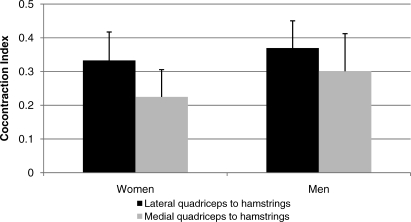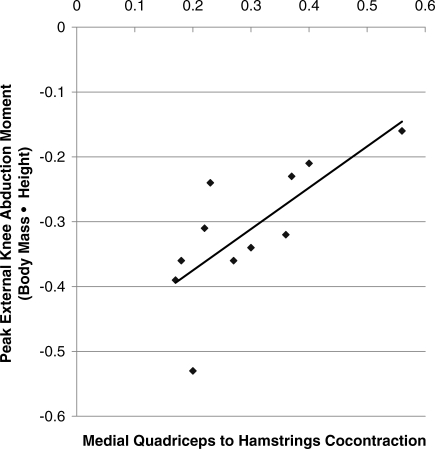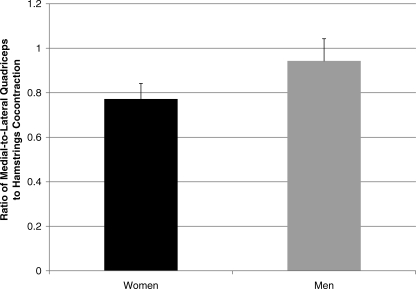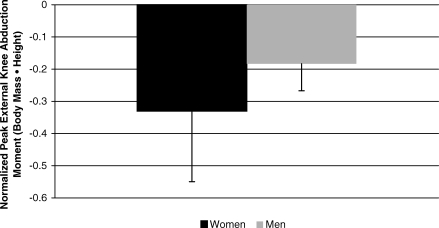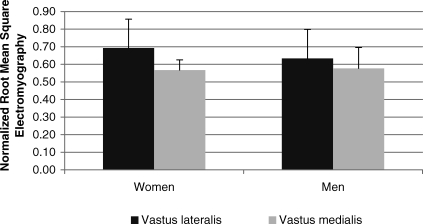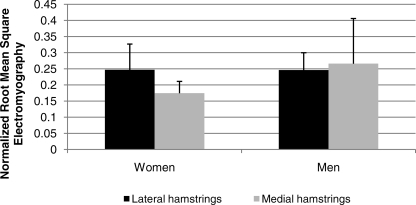Abstract
Context:
Sex differences in neuromuscular control of the lower extremity have been identified as a potential cause for the greater incidence of anterior cruciate ligament (ACL) injuries in female athletes compared with male athletes. Women tend to land in greater knee valgus with higher abduction loads than men. Because knee abduction loads increase ACL strain, the inability to minimize these loads may lead to ACL failure.
Objective:
To investigate the activation patterns of the quadriceps and hamstrings muscles with respect to the peak knee abduction moment.
Design:
Cross-sectional study.
Setting:
Neuromuscular research laboratory.
Patients or Other Participants:
Twenty-one recreationally active adults (11 women, 10 men).
Main Outcome Measure(s):
Volunteers performed 3 trials of a 100-cm forward hop. During the hop task, we recorded surface electromyographic data from the medial and lateral hamstrings and quadriceps and recorded lower extremity kinematics and kinetics. Lateral and medial quadriceps-to-hamstrings (Q∶H) cocontraction indices, the ratio of medial-to-lateral Q∶H cocontraction, normalized root mean square electromyographic data for medial and lateral quadriceps and hamstrings, and peak knee abduction moment were calculated and used in data analyses.
Results:
Overall cocontraction was lower in women than in men, whereas activation was lower in the medial than in the lateral musculature in both sexes (P < .05). The medial Q∶H cocontraction index (R2 = 0.792) accounted for a significant portion of the variance in the peak knee abduction moment in women (P = .001). Women demonstrated less activation in the vastus medialis than in the vastus lateralis (P = .49) and less activation in the medial hamstrings than in the lateral hamstrings (P = .01).
Conclusions:
Medial-to-lateral Q∶H cocontraction appears to be unbalanced in women, which may limit their ability to resist abduction loads. Because higher abduction loads increase strain on the ACL, restoring medial-to-lateral Q∶H cocontraction balance in women may help reduce ACL injury risk.
Keywords: neuromuscular system, biomechanics, landings, anterior cruciate ligament, coactivation
Key Points
The medial-to-lateral quadriceps-to-hamstrings cocontraction ratio was unbalanced in women, which may have contributed to their higher knee abduction loads.
The women in our study had larger external peak abduction moments than their male counterparts during the forward hop task.
Balancing medial-to-lateral quadriceps-to-hamstrings activation in women may help resist the abduction loads about the knee and may help to diminish the risk of anterior cruciate ligament injury.
Female athletes who participate in comparable jumping and cutting sports are 2 to 9 times more likely than their male counterparts to sustain an anterior cruciate ligament (ACL) rupture.1,2 This disparity in injury rates is most likely multifactorial and attributable to one or more of the following categories of risk factors: environmental, hormonal, anatomical, neuromuscular, and biomechanical.3,4 Because neuromuscular and biomechanical factors are believed to be modifiable, they have received considerable attention from scientists and clinicians.
Knee abduction loading appears to be a critical component to the ACL injury mechanism because it has been shown to prospectively predict ACL injury risk.5 Compared with male athletes, female athletes tend to generate greater abduction loads during cutting and landing,6,7 which may, in part, explain the discrepancy in injury rates observed between the sexes. Authors of in vitro and modeling studies have suggested that excessive loading in the frontal plane is capable of increasing relative ACL strain8 and may ultimately lead to ligamentous failure,9 so the ability of the muscles about the knee to control applied abduction loads in vivo is of particular interest.
The quadriceps and hamstrings muscles have the potential to provide dynamic frontal-plane knee stability because of their abduction and/or adduction moment arms.10 Using a neuromuscular biomechanical model, Lloyd et al11 noted that the quadriceps and hamstrings not only have the potential to support frontal-plane moments but also actually do provide support to abduction-adduction moments. Furthermore, they observed that these muscle groups appear capable of supporting up to 100% of the applied abduction-adduction loads.
Two generalized neuromuscular activation strategies have been proposed to counter external loading at the knee during dynamic tasks.10,12 One strategy involves a selective activation of muscles with the mechanical ability to counter the applied load, and the other involves an indiscriminate cocontraction without selectivity based upon mechanical advantage. Both strategies have been shown to stabilize the knee joint in the frontal plane during isometric loads.10,13–15 In addition, the appearance of similar cocontraction patterns during sport-specific tasks that load the knee in the frontal plane suggests that they may work to stabilize the knee during dynamic tasks as well.16 Available evidence suggests that women may employ a selective activation strategy that promotes abduction loading, which is a component of the ACL injury mechanism.17–19 Women appear to preferentially activate the lateral quadriceps17,18 and hamstrings18,19 while concurrently displaying less medial thigh muscle activation.17,18 Because selective activation of the medial knee musculature promotes resistance of abduction loads,13 the strategy that women employ may be harmful to the ACL. Providing further support to the idea that the unbalanced lateral-to-medial activation may be detrimental, Palmieri-Smith et al18 noted that less preparatory activation of the vastus medialis and more preparatory activation of the vastus lateralis and biceps femoris in women were associated with larger valgus knee angles, which predict ACL injury risk.5 If women land and cut with inadequate medial muscle activation (quadriceps and hamstrings), their ability to resist abduction loads may be hampered, thereby promoting excessive knee abduction loading and placing unnecessary strain on the ACL. Consequently, it is important to understand the neuromuscular deficiencies that may exist and perpetuate these higher frontal-plane knee load states.
Therefore, the purpose of our investigation was to examine quadriceps and hamstrings muscle activation to determine whether cocontraction of these muscle groups is associated with the peak external knee abduction moment in men and women. Our first hypothesis was that unbalanced medial-to-lateral quadriceps-to-hamstrings (Q∶H) cocontraction would be present in women. Our second hypothesis was that the medial Q∶H cocontraction index and the medial-to-lateral Q∶H cocontraction ratio would account for a significant proportion of the variance in the peak external knee abduction moment exhibited. Our rationale for examining the relationship between medial muscle activation and the peak knee abduction moment was based upon data showing that medial musculature is a key dynamic restraint to knee abduction loading.13 Our third hypothesis was that external peak knee abduction moments would be larger in women than in men.
METHODS
Experimental Design
We employed a cross-sectional study design. The dependent variables were medial Q∶H cocontraction index; lateral Q∶H cocontraction index; ratio of medial-to-lateral Q∶H cocontraction; normalized root mean square electromyography (EMG) for the vastus medialis, vastus lateralis, medial hamstrings, and lateral hamstrings; and peak external knee abduction moment.
Participants
Eleven women (age = 24.0 ± 5.2 years, height = 162.8 ± 6.6 cm, mass = 55.9 ± 7.3 kg) and 10 men (age = 23.6 ± 3.8 years, height = 174.1 ± 7.0 cm, mass = 67.9 ± 7.3 kg) volunteered to participate. Volunteers had no history of knee injury or knee surgery, no knee pain at the time of the study, and no lower extremity injury in the 6 months before the study. All participants were considered recreationally active, which was defined as exercising at least twice per week and having Tegner scores of 5, 6, or 7.20 Next, we recorded the dominant leg of each participant. The dominant leg was defined as the leg that the participant used to kick a ball. All participants provided informed consent, and the study was approved by the university's institutional review board.
Instrumentation
The movements of the lower extremity (thigh, shank, and foot) segment of interest were defined based on the 3-dimensional (3-D) coordinates of 17 precisely located retroreflective markers (thigh triad, shank triad, heel, head of fifth metatarsal, medial and lateral malleoli, medial and lateral femoral condyles, right and left greater trochanters, right and left anterior-superior iliac spines, and sacrum) that were tracked via an 8-camera, high-speed (120-Hz) motion capture system (Motion Analysis Corp, Santa Rosa, CA; Figure 1). Both static and dynamic system calibrations were performed, and residuals of less than 2.5 mm from each camera were deemed acceptable per the manufacturer's recommendations. We recorded an initial static (neutral) trial of each participant aligned with the laboratory coordinate system,21 enabling necessary transformations between dynamic (movement trials) and local anatomically relevant segment coordinate systems to be defined.9
Figure 1. Retroreflective marker placement. A, Front view. B, Side view. The markers on the medial aspect of the knee, on the medial aspect of the ankle, and on the left and right anterior-superior iliac spine were used only during a static trial (to configure each participant with the global coordinate system) and were removed before the dynamic landing trials were performed.
For each trial, participants were required to land on a force platform (model OR6-7; Advanced Mechanical Technology, Inc, Watertown, MA), which was located in the middle of the capture volume for the cameras and used to collect ground reaction force data. Ground reaction force data were sampled at 1200 Hz and were synchronized with the Motion Analysis system for simultaneous collection.
To monitor muscle activity, the skin for each electrode site was shaved and cleaned with alcohol. We secured pregelled Ag/AgCl bipolar surface EMG electrodes with a diameter of 1.1 cm and an interelectrode distance of 3.5 cm over the muscle bellies and in line with the muscle fibers of the vastus medialis, vastus lateralis, medial hamstrings, and lateral hamstrings, according to the technique described by Delagi et al.22 A single ground electrode was placed on the right ulnar styloid process. Raw dynamic EMG data and EMG data gathered during maximal voluntary isometric contractions (MVICs) were collected with a commercial telemetered EMG system (Konigsberg Instruments, Inc, Pasadena, CA) that was synchronized with the Motion Analysis system and also sampled at 1200 Hz.
Testing Procedures
Before initiating data collection, participants performed 3 MVICs for both the quadriceps and hamstrings with 10 seconds of rest between contractions. For the quadriceps contractions, participants were seated with the knee in 90° of flexion. For the hamstrings contractions, participants were positioned prone with the knee in 20° of flexion. When positioned, participants were instructed to hold the extension or flexion contraction for approximately 5 seconds against resistance from the examiner. After completion of the MVICs, participants were allotted time to practice the forward hop task until they felt comfortable with the procedure. The forward hop is a single-leg takeoff and landing, and we used it to simulate the rapid deceleration that occurs during sport. To perform the forward hop, participants stood on the dominant leg behind a line 100 cm from the front edge of the force platform.23 Participants were instructed to keep their hands on their hips or crossed at the chest, jump off the dominant leg, and land on the force platform on the same leg. If a participant missed the force platform or landed on both legs, the trial was considered unsuccessful and repeated. Participants were required to complete 3 successful trials in their athletic shoes.
Data Analysis
From the standing trial, a kinematic model comprising 4 skeletal segments (pelvis, thigh, shank, and foot) and 15 degrees of freedom was defined using Visual3D software (C-Motion, Inc, Germantown, MD). This software adopts a global least-squares optimization approach24 and has been used successfully to quantify joint kinematics for other dynamic movements.25 For our study, the pelvis was assigned 6 degrees of freedom relative to the global (laboratory) coordinate system, with the hip, knee, and ankle defined locally and each assigned 3 rotational degrees of freedom. The 3-D marker trajectories recorded during each forward hop trial were subsequently processed within the respective participant's Visual3D model to solve for the generalized coordinates of each frame. Joint kinematics were expressed relative to the neutral (global laboratory coordinate system), where all segments were initially aligned.9,26 Next, marker trajectories were processed with a fourth-order, zero-lag, low-pass Butterworth filter with a cutoff frequency of 6 Hz.
Three-dimensional intersegmental forces and moments were obtained by submitting the filtered kinematic and ground reaction force data to a conventional inverse dynamics analysis27 via the Visual3D software. Segment inertial characteristics were estimated based on anthropometric measurements of the participants.28 All lower extremity segments were modeled as frusta of cones, and the pelvis was modeled as a cylinder. The 3-D intersegmental forces at the knee joint were transformed to the tibial reference frame to obtain anterior-posterior, medial-lateral, and compression-distraction forces. Intersegmental knee moments were expressed as flexion-extension, adduction-abduction, and internal-external rotation moments with respect to the Cardanic axes of the local joint coordinate system.29 We defined joint moments as the external loads applied at each joint. For instance, the term knee abduction moment was used to describe an external load that moves the knee into an abducted posture. Furthermore, data convention was such that external knee abduction moments were denoted as negative. The peak external knee abduction moments were subsequently recorded for each landing trial, normalized to body mass and height, and used in the ensuing statistical treatment.
Electromyographic data were filtered with a fourth-order, zero-lag, high-pass Butterworth filter with a cutoff frequency of 20 Hz to attenuate movement artifacts and were processed with a 50-millisecond root mean square moving window. The peak amplitude gathered from the 3 MVICs was recorded. Dynamic EMG data recorded during the forward hops were normalized to the larger of either the peak of the 3 MVICs or the peak EMG activity during the landing task. Dynamic muscle activity was described from the time of ground contact to the time of the peak external knee abduction moment. Muscle cocontraction was assessed between the vastus lateralis and lateral hamstrings and between the vastus medialis and medial hamstrings. Cocontraction was determined using the equation described by Rudolph et al30:
where EMGS was the level of activity in the less active muscle and EMGL was the level of activity in the more active muscle. The index was multiplied by the sum of the activity found in the 2 muscles. The equation was applied to each data sample, and the resulting curve was averaged over the time from initial ground contact to the time of the peak external knee abduction moment. We also calculated the ratio of medial-to-lateral cocontraction by dividing the medial Q∶H cocontraction index by the lateral Q∶H cocontraction index. This ratio was calculated to determine whether cocontraction was imbalanced between the medial and lateral sides. The medial and lateral Q∶H cocontraction indices and the medial-to-lateral Q∶H cocontraction ratio were calculated for all 3 trials and averaged for statistical analysis.
Statistical Analysis
We used a 2 × 2 analysis of variance (ANOVA) to determine whether the medial and lateral cocontraction index differed between sides (medial, lateral) and sexes (male, female). We used 1-way ANOVAs to determine whether the ratio between medial and lateral cocontraction differed between men and women and to determine whether the peak external knee abduction moments differed between the sexes. Where appropriate, post hoc Bonferroni multiple comparison procedures were used. Two-tailed t tests for paired samples were used to examine whether vastus medialis activation differed from vastus lateralis activation and whether medial hamstrings activation differed from lateral hamstrings activation in men and women. Regression analyses were performed to examine possible associations between medial Q∶H cocontraction and the peak external knee abduction moment in men only, women only, and both sexes. Regression analyses were also used to examine associations between the ratio of medial-to-lateral Q∶H cocontraction and the peak external knee abduction moment in the same subgroups. The α level was set a priori at .05 for all tests.
RESULTS
Medial and Lateral Cocontraction Indices
The omnibus ANOVA revealed main effects for side (F1,19 = 4.59, P = .04) and sex (F1,19 = 8.91, P = .008) but did not reveal a side × sex interaction (F1,19 = 0.55, P = .446, 1 − β = .11). Women had lower overall cocontraction levels than men (0.26 ± 0.02 and 0.35 ± 0.02, respectively; P = .008). Both men and women had lower cocontraction levels in the medial musculature compared with the lateral musculature (0.279 ± 0.021 and 0.335 ± 0.018, respectively; P = .045; Figure 2).
Figure 2. Mean (± SD) lateral and medial Q∶H cocontraction indices for women and men participants. Both men and women demonstrated lower medial Q∶H cocontraction than lateral Q∶H cocontraction.
The medial Q∶H cocontraction index accounted for a significant portion of the variance in the peak external knee abduction moment in women (R2 = 0.792, b = 0.89, P = .001; Figure 3) but not in men (R2 = 0.05, b = 0.21, P = .53, 1 − β = .10, f2 = 0.05) or when both sexes were considered simultaneously in the model (R2 = 0.14, b = 0.20, P = .37, 1 − β = .14, f2 = 0.04).
Figure 3. Medial Q∶H cocontraction plotted against the external knee abduction moment in female participants.
Ratio of Medial-to-Lateral Cocontraction
The ratio of medial-to-lateral Q∶H cocontraction was lower in women than in men (0.772 ± 0.07 and 0.943 ± 0.10, respectively; F1,19 = 3.23, P = .042; Figure 4). This ratio accounted for a significant portion of the variance in the peak external knee abduction moment in women (R2 = 0.399, b = 0.63, P = .05) but not in men (R2 = 0.03, b = 0.19, P = .59, 1 − β = .08, f2 = 0.03) or when both sexes were considered simultaneously in the model (R2 = 0.03, b = 0.17, P = .45, 1 − β = .11, f2 = 0.03).
Figure 4. Ratio of medial-to-lateral Q∶H cocontraction for the women and men participants. The ratio of cocontraction was lower for women than for men (P < .05).
Peak Knee Abduction Moment
Normalized peak external knee abduction moments were larger in women than in men (−0.330 ± 0.22 Nm/kg and −0.183 ± 0.08 Nm/kg, respectively; F1,19 = 4.30, P = .05; Figure 5).
Figure 5. Mean (± SD) normalized peak knee abduction moments for women and men participants. Abduction moments were higher for women than for men (P < .05).
Individual Muscle Activation
Women demonstrated less activation in the vastus medialis than in the vastus lateralis (0.567 ± 0.058 and 0.692 ± 0.164, respectively) and less activation in the medial hamstrings than in the lateral hamstrings (0.175 ± 0.037 and 0.247 ± 0.080, respectively; P ≤ .05; Figures 6 and 7). No differences were noted for the men between the vastus lateralis and vastus medialis (0.633 ± 0.165 and 0.577 ± 0.199, respectively; P = .84, 1 − β = .23, d = 0.39) or between the lateral hamstrings and medial hamstrings (0.246 ± 0.054 and 0.266 ± 0.140, respectively; P = .48, 1 − β = .11, d = 0.19; Figures 6 and 7).
Figure 6. Mean (± SD) normalized lateral quadriceps EMG for women and men participants. Women displayed greater vastus lateralis activation than vastus medialis activation (P = .49).
Figure 7. Mean (± SD) normalized lateral and medial hamstrings EMG for women and men participants. Women displayed greater lateral hamstrings activation than medial hamstrings activation (P = .01).
DISCUSSION
The results, in part, supported our hypotheses that women would exhibit unbalanced medial-to-lateral Q∶H cocontraction and that the medial Q∶H cocontraction index would be associated with the external peak knee abduction moment (women only). These neuromuscular patterns at the knee, which result in a diminished ability to resist external abduction loads, may contribute to the increased number of ACL tears seen in women.
In the frontal plane, balanced cocontraction of the quadriceps and hamstrings leads to increased joint compression, which should assist in knee joint stabilization. In fact, muscular cocontraction has been shown to decrease frontal-plane motion up to 3-fold.31 Our results suggest that women cocontract their quadriceps and hamstrings to a lesser extent than men do. The diminished coactivation between the quadriceps and hamstrings in women may contribute to greater knee joint instability in women than in men.
Substantial varus-valgus loads are placed on the knee during sports maneuvers,11,32 so appropriate neuromuscular activation strategies capable of countering such loads must be in place, because without such dynamic stabilization, ligamentous rupture would occur. One way to minimize applied varus-valgus loads at the knee is to selectively activate muscles with the appropriate moment arms to counter these loads. Another method is to generate a generalized cocontraction of all muscles about the joint. Both selective and generalized cocontraction strategies can be effective.10,13–15 Selective cocontraction of the medial musculature, which has a varus moment arm, and selective activation of lateral musculature, which has a valgus moment arm, would appear to be appropriate ways to reduce abduction and adduction loads, respectively. In fact, Zhang and Wang13 showed that medial thigh muscle activation is important in providing resistance to abduction loads and minimizing valgus laxity and that lateral thigh muscle activation is critical for opposing adduction loads and reducing varus laxity. The men and women in our study appeared to selectively activate muscles during the landing task, with predominant lateral coactivation; however, their strategy appears to be the opposite of what would be effective for resisting abduction loads. In fact, selective activation of the lateral muscles would tend to perpetuate abduction loading. This activation strategy is perplexing because the peak loads in the frontal plane during our task were abduction rather than adduction.
Although both sexes did not equally cocontract their lateral-to-medial thigh musculature, the medial Q∶H ratio was only able to predict peak knee abduction moment in the female participants, suggesting that medial Q∶H cocontraction was connected to controlling abduction loading in the women but not in the men. We believe that this might be attributed to a possible threshold effect at which low medial cocontraction affects the peak knee abduction moment. In other words, a certain percentage difference between lateral and medial muscle cocontraction may be needed before the peak abduction moment is affected. Supporting this hypothesis is the finding that the ratio of medial-to-lateral Q∶H cocontraction was less in the women than in the men, illustrating that the imbalance between the lateral and medial Q∶H cocontraction was greater in the women than in the men.
Although the medial-to-lateral Q∶H cocontraction imbalance was greater in the women than in the men, this finding still does not fully explain why medial muscle activation was not related to the peak knee abduction moment in male participants. Other medial musculature (gracilis, medial gastrocnemius) might be more important in the men for controlling frontal-plane loads. If we had considered other muscle groups in our analyses, we might have found different results.
The unbalanced activation strategy demonstrated by the women could harm rather than help the knee joint. Women displayed a lower ratio of medial-to-lateral cocontraction, which was associated with higher knee abduction moments. Based on the finding that knee abduction loads prospectively predict ACL injury risk,5 it appears that this neuromuscular pattern may be harmful to the female ACL by failing to resist injurious loads. This unbalanced activation strategy that women employ may also contribute to the sex bias in ACL ruptures.
The men in our study displayed an unbalanced activation strategy that was similar to the strategy of the women, but the magnitude of their imbalance was less. Why the men displayed a larger medial-to-lateral activation ratio than the women is unknown, but neuromuscular activation patterns have been shown to differ between the sexes.7,33,34 Apparent neuromuscular differences between men and women have been hypothesized to contribute to the sex bias in ACL ruptures.4,35 Based on our findings, we suggest that the activation strategy adopted by men would be more effective than the strategy adopted by women in reducing abduction loading patterns.
Our finding of greater vastus lateralis and lateral hamstrings activation in women is supported by earlier research. Rozzi et al19 found that female basketball players demonstrated greater lateral hamstrings activation (ie, higher EMG peak amplitude and area) than men upon landing from a jump. Myer et al17 found that women had greater lateral-to-medial quadriceps activation indices compared with men when performing an exercise to mimic an ACL injury-risk position. Why women tend to preferentially activate their lateral quadriceps and hamstrings remains unknown. Rozzi et al19 suggested that increased lateral hamstrings activation in women was a protective strategy chosen to improve knee joint stability. Because the moment arm of the biceps femoris allows it to act as a synergist to the ACL by resisting anterior tibial translation, the investigators proposed that heightened lateral hamstrings activation may aid in minimizing anterior knee joint laxity. Activation of the lateral hamstrings may also be used to reduce applied internal rotation moments, which could harm the ACL.16 Both of these hypotheses may be true, but, when considered along with our results, we postulate that the hamstrings activation pattern could be considered harmful rather than protective, at least when considering frontal-plane loading patterns.
The women in our study had larger peak knee external abduction moments than their male counterparts during the forward hop task. This result is consistent with previous research examining lower extremity mechanics during cutting6 and landing36 maneuvers, but it disagrees with the work of others.37,38 In a cadaver study, application of external abduction loads resulted in up to a 30% increase in relative ACL strain and may contribute to ACL injury risk.39 Thus, the finding of larger knee abduction moments in the female participants may help to explain why women are more at risk for ACL rupture.
Based on the available evidence, minimizing the external abduction loading at the knee during landing, cutting, and pivoting tasks could help to reduce the risk of ACL rupture. Our results suggest that balancing medial-to-lateral Q∶H activation in women may help them to resist the abduction loads about the knee and may help to diminish the risk of ACL injury. Sportsmetrics, which is a plyometric training program, has been effective in reducing varus and valgus torques in women and, thus, may be effective in minimizing the incidence of ACL injury.40 Although this program may be effective, the neuromuscular and biomechanical changes that result from the training and lead to the reduced injury incidence remain unknown. Medial-to-lateral Q∶H cocontraction possibly becomes more balanced after the training program, but prospective studies need to be completed to investigate this hypothesis.
One could argue that the quadriceps muscles cannot preferentially control either abduction (vastus medialis) or adduction (vastus lateralis) because they have a common insertion on the patellar tendon. However, both muscles have additional insertions into the knee joint capsule and possibly the collateral ligaments.41 Therefore, the medialis could have a varus moment arm, and the lateralis could have a valgus moment arm, which is why we considered them as such, as other researchers have done.16,42
Limitations
Our study had limitations. First, the distance of the hop was not normalized, which could have affected the ability of the shorter participants to perform the task. The task appeared to be equally challenging for all participants; however, in future studies, normalizing the distance of the hop to each participant's leg length may be appropriate. Second, when conducting the analyses for the male participants, power was suboptimal, which likely affected our ability to detect differences in this population. However, when taking into account the small effect sizes accompanying the low power values, we question whether a significant result in this case would be clinically important.
CONCLUSIONS
Medial-to-lateral Q∶H cocontraction was unbalanced in women, which may contribute to higher knee abduction loads in this population. Because higher abduction loads increase strain on the ACL, restoring medial-to-lateral Q∶H cocontraction balance in women may help to reduce ACL injury risk.
Acknowledgments
We thank Catherine Kinnard, Jennifer Kreinbrink, and Jagbir Khangura for their assistance with data collection.
Footnotes
Riann M. Palmieri-Smith, PhD, ATC, contributed to conception and design; acquisition and analysis and interpretation of the data; and drafting, critical revision, and final approval of the article. Scott G. McLean, PhD, contributed to analysis and interpretation of the data and drafting, critical revision, and final approval of the article. James A. Ashton-Miller, PhD, and Edward M. Wojtys, MD, contributed to conception and design and drafting, critical revision, and final approval of the article.
REFERENCES
- 1.Arendt E, Dick R. Knee injury patterns among men and women in collegiate basketball and soccer: NCAA data and review of literature. Am J Sports Med. 1995;23(6):694–701. doi: 10.1177/036354659502300611. [DOI] [PubMed] [Google Scholar]
- 2.Gwinn D.E, Wilckens J.H, McDevitt E.R, Ross G, Kao T.C. The relative incidence of anterior cruciate ligament injury in men and women at the United States Naval Academy. Am J Sports Med. 2000;28(1):98–102. doi: 10.1177/03635465000280012901. [DOI] [PubMed] [Google Scholar]
- 3.Huston L.J, Greenfield M.L, Wojtys E.M. Anterior cruciate ligament injuries in the female athlete: potential risk factors. Clin Orthop Relat Res. 2000;372:50–63. doi: 10.1097/00003086-200003000-00007. [DOI] [PubMed] [Google Scholar]
- 4.Griffin L.Y, Agel J, Albohm M.J, et al. Noncontact anterior cruciate ligament injuries: risk factors and prevention strategies. J Am Acad Orthop Surg. 2000;8(3):141–150. doi: 10.5435/00124635-200005000-00001. [DOI] [PubMed] [Google Scholar]
- 5.Hewett T.E, Myer G.D, Ford K.R, et al. Biomechanical measures of neuromuscular control and valgus loading of the knee predict anterior cruciate ligament injury risk in female athletes: a prospective study. Am J Sports Med. 2005;33(4):492–501. doi: 10.1177/0363546504269591. [DOI] [PubMed] [Google Scholar]
- 6.McLean S.G, Huang X, van den Bogert A.J. Association between lower extremity posture at contact and peak knee valgus moment during sidestepping: implications for ACL injury. Clin Biomech (Bristol, Avon) 2005;20(8):863–870. doi: 10.1016/j.clinbiomech.2005.05.007. [DOI] [PubMed] [Google Scholar]
- 7.McLean S.G, Fellin R.E, Suedekum N, Calabrese G, Passerallo A, Joy S. Impact of fatigue on gender-based high-risk landing strategies. Med Sci Sports Exerc. 2007;39(3):502–514. doi: 10.1249/mss.0b013e3180d47f0. [DOI] [PubMed] [Google Scholar]
- 8.Withrow T.J, Huston L.J, Wojtys E.M, Ashton-Miller J.A. Valgus loading causes increased ACL strain in vitro in simulated jump landing. Paper presented at: 51st annual meeting of the Orthopaedic Research Society; February 23–28, 2005; Washington, DC.
- 9.McLean S.G, Huang X, Su A, van den Bogert A.J. Sagittal plane biomechanics cannot injure the ACL during sidestep cutting. Clin Biomech (Bristol, Avon) 2004;19(8):828–838. doi: 10.1016/j.clinbiomech.2004.06.006. [DOI] [PubMed] [Google Scholar]
- 10.Lloyd D.G, Buchanan T.S. Strategies of muscular support of varus and valgus loads at the human knee. J Biomech. 2001;34(10):1257–1267. doi: 10.1016/s0021-9290(01)00095-1. [DOI] [PubMed] [Google Scholar]
- 11.Lloyd D.G, Buchanan T.S, Besier T.F. Neuromuscular biomechanical modeling to understand knee ligament loading. Med Sci Sports Exerc. 2005;37(11):1939–1947. doi: 10.1249/01.mss.0000176676.49584.ba. [DOI] [PubMed] [Google Scholar]
- 12.Llewellyn M, Yang Y.F, Prochazka A. Human H-reflexes are smaller in difficult beam walking than in normal treadmill walking. Exp Brain Res. 1990;83(1):22–28. doi: 10.1007/BF00232189. [DOI] [PubMed] [Google Scholar]
- 13.Zhang L.Q, Wang G. Dynamic and static control of the human knee joint in abduction-adduction. J Biomech. 2001;34(9):1107–1115. doi: 10.1016/s0021-9290(01)00080-x. [DOI] [PubMed] [Google Scholar]
- 14.Buchanan T.S, Lloyd D.G. Muscle activation at the human knee during isometric flexion-extension and varus-valgus loads. J Orthop Res. 1997;15(1):11–17. doi: 10.1002/jor.1100150103. [DOI] [PubMed] [Google Scholar]
- 15.Lloyd D.G, Buchanan T.S. A model of load sharing between muscles and soft tissues at the human knee during static tasks. J Biomech Eng. 1996;118(3):367–376. doi: 10.1115/1.2796019. [DOI] [PubMed] [Google Scholar]
- 16.Besier T.F, Lloyd D.G, Ackland T.R. Muscle activation strategies at the knee during running and cutting maneuvers. Med Sci Sports Exerc. 2003;35(1):119–127. doi: 10.1097/00005768-200301000-00019. [DOI] [PubMed] [Google Scholar]
- 17.Myer G.D, Ford K.R, Hewett T.E. The effects of gender on quadriceps muscle activation strategies during a maneuver that mimics a high ACL injury risk position. J Electromyogr Kinesiol. 2005;15(2):181–189. doi: 10.1016/j.jelekin.2004.08.006. [DOI] [PubMed] [Google Scholar]
- 18.Palmieri-Smith R.M, Wojtys E.M, Ashton-Miller J.A. Association between preparatory muscle activation and peak valgus knee angle. J Electromyogr Kinesiol. 2008;18(6):973–979. doi: 10.1016/j.jelekin.2007.03.007. [DOI] [PubMed] [Google Scholar]
- 19.Rozzi S.L, Lephart S.M, Gear W.S, Fu F.H. Knee joint laxity and neuromuscular characteristics of male and female soccer and basketball players. Am J Sports Med. 1999;27(3):312–319. doi: 10.1177/03635465990270030801. [DOI] [PubMed] [Google Scholar]
- 20.Tegner Y, Lysholm J. Rating systems in the evaluation of knee ligament injuries. Clin Orthop Relat Res. 1985;198:43–49. [PubMed] [Google Scholar]
- 21.McLean S.G, Su A, van den Bogert A.J. Development and validation of a 3-D model to predict knee joint loading during dynamic movement. J Biomech Eng. 2003;125(6):864–874. doi: 10.1115/1.1634282. [DOI] [PubMed] [Google Scholar]
- 22.Delagi E.F, Iazzetti J, Perotto A, Morrison D. Anatomic Guide for the Electromyographer. Springfield, IL: Charles C Thomas; 1981. [Google Scholar]
- 23.Hart J.M, Garrison J.C, Kerrigan D.C, Palmieri-Smith R.M, Ingersoll C.D. Gender differences in gluteus medius muscle activity exist in soccer players performing a forward jump. Res Sports Med. 2007;15(2):147–155. doi: 10.1080/15438620701405289. [DOI] [PubMed] [Google Scholar]
- 24.Lu T.W, O'Connor J.J. Bone position estimation from skin marker co-ordinates using global optimisation with joint constraints. J Biomech. 1999;32(2):129–134. doi: 10.1016/s0021-9290(98)00158-4. [DOI] [PubMed] [Google Scholar]
- 25.Ferber R, Davis I.M, Williams D.S., 3rd Gender differences in lower extremity mechanics during running. Clin Biomech (Bristol, Avon) 2003;18(4):350–357. doi: 10.1016/s0268-0033(03)00025-1. [DOI] [PubMed] [Google Scholar]
- 26.Wu G, Siegler S, Allard P, et al. ISB recommendation on definitions of joint coordinate system of various joints for the reporting of human joint motion, part I: ankle, hip, and spine. International Society of Biomechanics. J Biomech. 2002;35(4):543–548. doi: 10.1016/s0021-9290(01)00222-6. [DOI] [PubMed] [Google Scholar]
- 27.Winter D.A. Biomechanics and Motor Control of Human Movement. 3rd ed. Hoboken, NJ: John Wiley and Sons; 2005. pp. 75–102. [Google Scholar]
- 28.Dempster W.T. Space Requirements of the Seated Operator: Geometrical, Kinematic, and Mechanical Aspects of the Body With Special Reference to the Limbs. Wright-Patterson Air Force Base, OH: US Air Force; 1955. WADC technical report 55-159. [Google Scholar]
- 29.Grood E.S, Suntay W.J. A joint coordinate system for the clinical description of three-dimensional motions: application to the knee. J Biomech Eng. 1983;105(2):136–144. doi: 10.1115/1.3138397. [DOI] [PubMed] [Google Scholar]
- 30.Rudolph K.S, Axe M.J, Snyder-Mackler L. Dynamic stability after ACL injury: who can hop. Knee Surg Sports Traumatol Arthrosc. 2000;8(5):262–269. doi: 10.1007/s001670000130. [DOI] [PubMed] [Google Scholar]
- 31.Markolf K.L, Burchfield D.M, Shapiro M.M, Shepard M.F, Finerman G.A, Slauterbeck J.L. Combined knee loading states that generate high anterior cruciate ligament forces. J Orthop Res. 1995;13(6):930–935. doi: 10.1002/jor.1100130618. [DOI] [PubMed] [Google Scholar]
- 32.Besier T.F, Lloyd D.G, Cochrane J.L, Ackland T.R. External loading of the knee joint during running and cutting maneuvers. Med Sci Sports Exerc. 2001;33(7):1168–1175. doi: 10.1097/00005768-200107000-00014. [DOI] [PubMed] [Google Scholar]
- 33.McLean S.G, Walker K.B, van den Bogert A.J. Effect of gender on lower extremity kinematics during rapid direction changes: an integrated analysis of three sports movements. J Sci Med Sport. 2005;8(4):411–422. doi: 10.1016/s1440-2440(05)80056-8. [DOI] [PubMed] [Google Scholar]
- 34.Landry S.C, McKean K.A, Hubley-Kozey C.L, Stanish W.D, Deluzio K.J. Neuromuscular and lower limb biomechanical differences exist between male and female elite adolescent soccer players during an unanticipated side-cut maneuver. Am J Sports Med. 2007;35(11):1888–1900. doi: 10.1177/0363546507300823. [DOI] [PubMed] [Google Scholar]
- 35.Ireland M.L. The female ACL: why is it more prone to injury. Orthop Clin North Am. 2002;33(4):637–651. doi: 10.1016/s0030-5898(02)00028-7. [DOI] [PubMed] [Google Scholar]
- 36.Chappell J.D, Yu B, Kirkendall D.T, Garrett W.E. A comparison of knee kinetics between male and female recreational athletes in stop-jump tasks. Am J Sports Med. 2002;30(2):261–267. doi: 10.1177/03635465020300021901. [DOI] [PubMed] [Google Scholar]
- 37.Chaudhari A.M, Lindenfeld T.N, Andriacchi T.P, et al. Knee and hip loading patterns at different phases in the menstrual cycle: implications for the gender difference in anterior cruciate ligament injury rates. Am J Sports Med. 2007;35(5):793–800. doi: 10.1177/0363546506297537. [DOI] [PubMed] [Google Scholar]
- 38.Sigward S.M, Powers C.M. The influence of gender on knee kinematics, kinetics and muscle activation patterns during side-step cutting. Clin Biomech (Bristol, Avon) 2006;21(1):41–48. doi: 10.1016/j.clinbiomech.2005.08.001. [DOI] [PubMed] [Google Scholar]
- 39.Withrow T.J, Huston L.J, Wojtys E.M, Ashton-Miller J.A. The effect of an impulsive knee valgus moment on in vitro relative ACL strain during a simulated jump landing. Clin Biomech (Bristol, Avon) 2006;21(9):977–983. doi: 10.1016/j.clinbiomech.2006.05.001. [DOI] [PubMed] [Google Scholar]
- 40.Myer G.D, Ford K.R, Palumbo J.P, Hewett T.E. Neuromuscular training improves performance and lower-extremity biomechanics in female athletes. J Strength Cond Res. 2005;19(1):51–60. doi: 10.1519/13643.1. [DOI] [PubMed] [Google Scholar]
- 41.Calliet R. Knee Pain and Disability. 3rd ed. Philadelphia, PA: FA Davis; 1992. pp. 20–26. [Google Scholar]
- 42.Buchanan T.S, Kim A.W, Lloyd D.G. Selective muscle activation following rapid varus/valgus perturbations at the knee. Med Sci Sports Exerc. 1996;28(7):870–876. doi: 10.1097/00005768-199607000-00014. [DOI] [PubMed] [Google Scholar]




